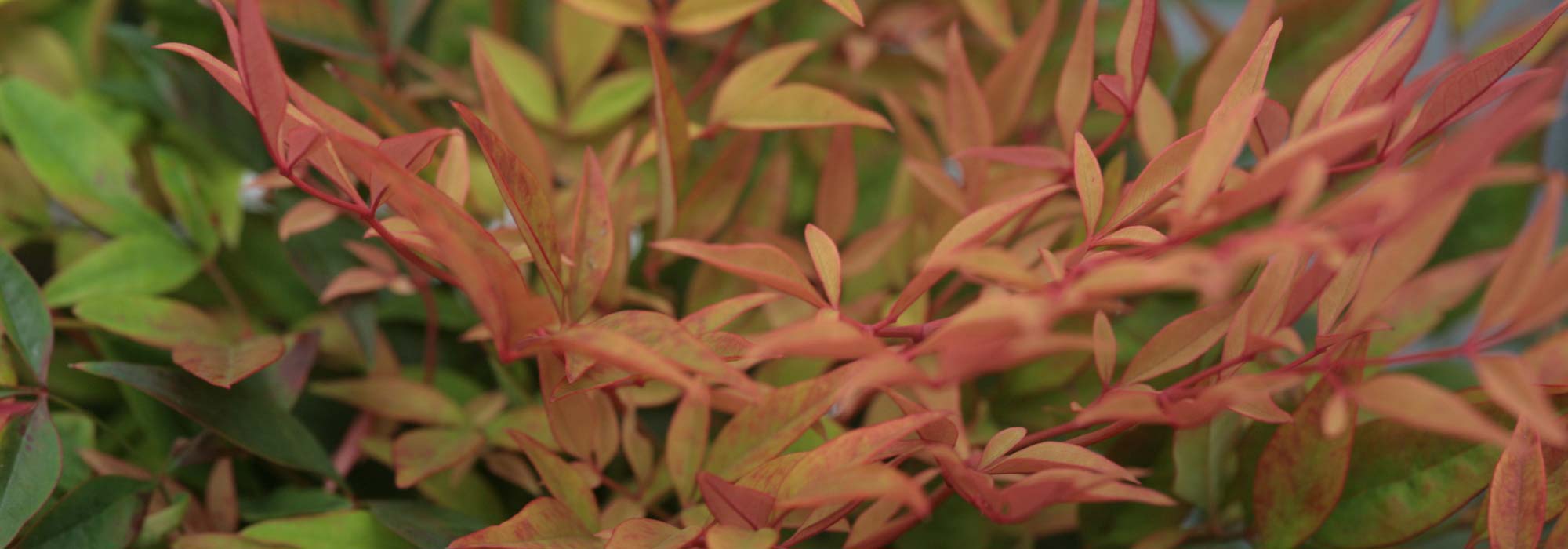
Sacred bamboo, Nandina domestica: planting, pruning, care
Contents
Sacred Bamboo in a nutshell
- Nandina or “sacred bamboo” is a remarkable evergreen bush with foliage that changes throughout the seasons, transitioning from red to green and finally to purple
- Its generous summer flowering, in large white panicles, is fresh and subtle
- It is also sumptuous at the end of the season, covered in small, bright red berries
- Accommodating, it withstands summer drought well and is hardy down to -12/-15°C
- Versatile and highly graphic, it is ideal in small shrub beds or in pots in partial shade
A word from our expert
Nandina, also known as “Sacred Bamboo”, is one of the few bushes that possesses evergreen foliage, with a colour that evolves throughout the seasons, changing from red in spring to green in summer, and finally becoming reddish-orange to purplish in autumn. It offers all the shades of autumn foliage without dropping!
Compact in size, nandina domestica can reach a height of 60 cm to 2 m depending on the variety. There are even dwarf nandinas that do not exceed 60 cm in all directions, perfect for rockeries, ground cover, or pots.
Whether it is nandina domestica ‘Fire power’, ‘Richmond’, ‘Obsessed’, or ‘Gulf stream’, they all continuously recreate a joyful and changing scene in the garden.
Hardy down to -15°C, nandina withstands frost well if it is sheltered from the wind and adapts to all types of soil, even poor and stony, although it prefers cool, fertile, and well-drained soils.
Its relatively slow growth, resistance to pollution, and modest size make it essential in all gardens, whether by the seaside or in cities, as well as in small gardens where it adds a touch of Japanese elegance.
Versatile, with its graceful appearance, it finds its place in flower beds, in cool rockeries, as a specimen, in free hedges, or in zen-inspired compositions, and will look magnificent in a large pot on a non-scorching terrace.
Discover our hardy and resilient Sacred Bamboos, these still relatively unknown bushes that cater to all desires. They will bring originality, lightness, and elegance to your garden throughout the seasons.
Description and Botany
Botanical data
- Latin name Nandina domestica
- Family Berberidaceae
- Common name Sacred bamboo, heavenly bamboo
- Flowering From July to September
- Height 0.60 to 2 m
- Exposure Sun, partial shade
- Soil type All, well-drained
- Hardiness -15°C
The Nandina domestica, also known as “Sacred bamboo” (“Heavenly bamboo” or “Bamboo of happiness”), is a persistent bush native to the wooded regions of India, China, and Japan, belonging to the Berberidaceae family, like barberry or Berberis. While it is stem-like like bamboo, the resemblance ends there; despite its nickname, it has no botanical relation to bamboo and does not belong to the same family.
The genus Nandina comprises only one species, domestica, which has given rise to around sixty cultivars in Japan, few of which are imported into our European gardens. Only a few, such as ‘Richmond’, ‘Obsessed’, ‘Fire Power’, or ‘Gulf Stream’, are cultivated in our latitudes.
The bush has a particularly bushy, upright, and compact habit with a beautifully rounded silhouette. With a rather slow growth rate, this rhizomatous plant grows stem-like like bamboo. The Sacred bamboo forms a clump of thin, upright, and branched stems supported by a cespitose stump. They can reach up to 1.80 m in height.
Nandina requires several years to sufficiently thicken. It propagates easily by seeds and suckering. Some dwarf or low species (‘Fire Power’) can serve as ground cover. Its bark is aromatic.
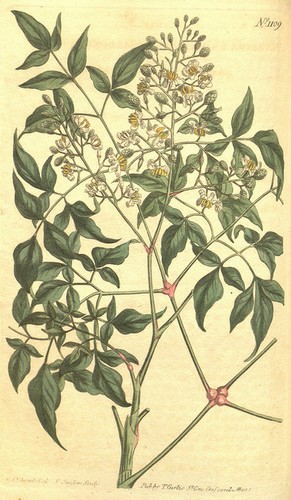
Nandina domestica – botanical illustration
The Sacred bamboo is distinguished by its beautiful, ample, and colourful foliage that persists in winter, brightening the garden throughout the year. Its light and changing foliage throughout the seasons is a valuable asset of this remarkable bush. Evergreen or semi-evergreen, it provides a delicate green backdrop that is attractive all year round. The Sacred bamboo will only lose its leaves if the temperature drops below -15°C.
The pinnate, lanceolate, or elliptical leaves are finely divided into narrow, pointed leaflets of 2.50 cm. Depending on the varieties, the foliage can be slender or frizzy. Nandina domestica ‘Filamentosa’ features extremely fine, spider-like foliage.
This light foliage reminiscent of bamboo has earned Nandina the common name of “sacred bamboo” or “wonderful bamboo.”
This dense yet slender vegetation forms wide horizontal umbrellas, measuring 50 to 90 cm long.
The leaf colours vary according to the cultivars. Nandina domestica ‘Twilight’ has light green foliage variegated with creamy white, while ‘Lemon Lime’ has a young spring foliage ranging from chartreuse green to lime green.
With each seasonal change, their colours evolve as they develop; pink-red to pink-orange during bud burst, they turn green with summer, transitioning from acid green to bronze green to blue-green, then adorn themselves with yellow, orange, and red at the end of the season. These vibrant autumn hues intensify with the cold.
Its summer flowering is subtle. In summer, from July to September, large, loose, conical panicles measuring 30 to 40 cm long, composed of tiny cream-white flowers, appear. With a beautiful waxy texture, they bear large yellow anthers that stand out against this light cloud.
 Various foliage: Nandina domestica ‘Twilight’, Nandina domestica ‘Lemon Lime’, Nandina domestica ‘Filamentosa’, Nandina domestica ‘Obsessed Seika’.
Various foliage: Nandina domestica ‘Twilight’, Nandina domestica ‘Lemon Lime’, Nandina domestica ‘Filamentosa’, Nandina domestica ‘Obsessed Seika’.
They are followed in autumn, depending on the varieties, by abundant clusters of bright red fruits measuring 4 to 8 mm in diameter. Some less common cultivars here bear yellow or white berries. Nandina offers one of the most abundant and long-lasting fruiting displays, especially following a warm summer.
Highly decorative, these scarlet berries persist for a long time on the branches, from winter to spring, remaining in harmony with the foliage reddened by autumn and then mingling with the young spring shoots, even with the new flowering.
Graphically, the flowering branches or those bearing fruit are used in Ikebana arrangements.
Originally, Nandina is a dioecious plant, meaning that fruiting only occurs if male and female plants are planted side by side. Today, there are hermaphrodite varieties (‘Richmond’) that are more fruitful, capable of producing berries abundantly, even in the absence of a nearby male plant. Some, however, like Nandina domestica ‘Lemon Lime’ or ‘Fire Power’, do not fruit or do so very little.
Inedible and toxic to humans (they contain nandenine), these drupes will, however, delight some birds during the harsh season.
Although it is relatively hardy (down to about -15 °C), the sacred bamboo prefers mild winters. It thrives almost everywhere in France, making it a very easy-to-cultivate shrub, especially in coastal gardens.
 Evolution of a nandina flower.
Evolution of a nandina flower.
It grows in partial shade or sunny situations, in ordinary soil, rich or poor, neutral or acidic, cool and well-drained, and especially protected from harsh cold and drying prevailing winds that it fears.
With its persistent and elegant foliage, and its compact size, Nandina is valuable for brightening the backgrounds of shaded shrub borders, a shaded rockery, or perennial beds. It can also be planted in a low mixed hedge. This small bush will also look magnificent in a large pot on the terrace, in a non-scorching exposure, or as a veranda or winter garden plant in colder regions.
In Asia, the Sacred bamboo has been cultivated for centuries, planted around temples or to adorn their altars; it is one of the sacred plants and symbolizes purification.
The sacred bamboo possesses medicinal properties, astringent and sedative, used for centuries in Asian pharmacopoeia.
Read also
Be attentive to evergreen bushesMain species and varieties
There is only one species of sacred bamboo, nandina domestica, but it is available in around sixty cultivars that vary greatly in colour and size, which are still very rarely imported here. ‘Richmond’ with its abundant fruiting, ‘Obsessed’, ‘Fire Power’ with its very compact habit, or ‘Gulf Stream’ are among the small selection of about fifteen varieties with changing foliage throughout the months, offered for the decoration of our gardens. Not all varieties are hermaphrodites: sacred bamboo will be more fruitful if at least two individuals are planted in the garden!
Some compact varieties like the dwarf nandina (‘Fire Power’) will serve as ground cover and are more suited to pot cultivation on a shaded terrace, reaching only about 60 cm in height, while others can grow up to 1.80 m tall (‘Plum Passion’).
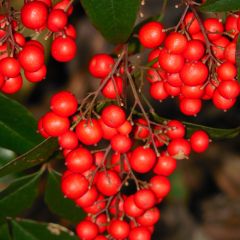
Nandina domestica Richmond - Sacred Bamboo
- Flowering time July to September
- Height at maturity 1,60 m
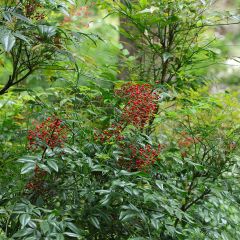
Nandina domestica - Sacred Bamboo
- Flowering time July to September
- Height at maturity 2 m
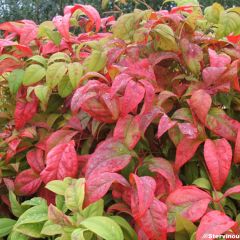
Nandina domestica Fire Power - Sacred Bamboo
- Flowering time July to September
- Height at maturity 60 cm

Nandina Obsessed Seika - Sacred Bamboo
- Flowering time July to September
- Height at maturity 1 m
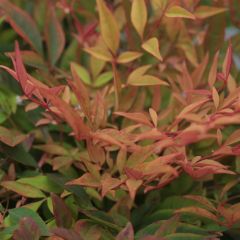
Nandina domestica Gulf Stream - Sacred Bamboo
- Flowering time July to September
- Height at maturity 1 m
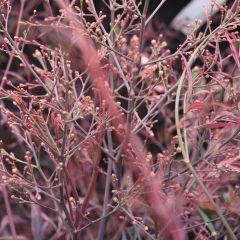
Nandina domestica Plum Passion - Sacred Bamboo
- Flowering time July to September
- Height at maturity 1,20 m
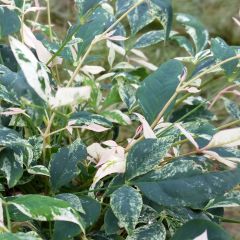
Nandina domestica Twilight - Sacred Bamboo
- Flowering time July to September
- Height at maturity 1,20 m
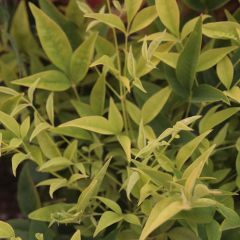
Nandina domestica Lemon Lime - Sacred Bamboo
- Flowering time July to September
- Height at maturity 70 cm
Discover other Nandina
View all →Available in 0 sizes
Available in 4 sizes
Available in 3 sizes
Available in 1 sizes
Available in 3 sizes
Available in 1 sizes
Available in 2 sizes
Available in 1 sizes
Available in 1 sizes
Available in 1 sizes
Young plantation
Where to plant Nandina or Sacred Bamboo?
The Nandina or Sacred Bamboo can be planted almost anywhere in France except in regions with harsh winters and in the south of France as it does not appreciate high temperatures. It prefers mild winters and not too hot summers.
With good hardiness, it is capable of withstanding temperatures down to -15°C for short periods if sheltered from cold, drying winds: planting in a location protected from extreme cold is necessary. It thrives well up to the Paris region. In colder areas, severe frosts can cause its beautiful coloured foliage to drop and damage its new spring shoots.
In harsh climates, it is quite feasible to grow Nandina in a pot and winter it in a conservatory or winter garden.
It is sensitive to heatwaves and prolonged drought when young; once well established, it will be fairly resistant to summer heat if the soil is deep.
Nandina enjoys sunny or lightly shaded exposures but never scorching. South of the Loire, it can tolerate occasionally dry soil with good mulching. In a Mediterranean climate, it is better to place it in a shaded spot, especially for variegated forms, which are more sensitive to scorching sun.
Avoid too dense shade, as it needs light to maintain well-coloured foliage. However, its evergreen foliage tolerates urban pollution and sea spray, making it an excellent choice for city gardens where it is abundantly planted, as well as for coastal areas.
While it adapts to any good ordinary soil, even poor or slightly calcareous well-drained soil, it prefers rich, rather acidic soil that remains cool in summer.
The Sacred Bamboo grows slowly, rarely exceeding 2 m in height at maturity, making it a compact shrub suitable for small gardens.
In a larger garden, it will look best when planted in groups of 3 to 5 plants in large plantings. Fruit production will be even more generous if at least two nandinas are planted in the garden!
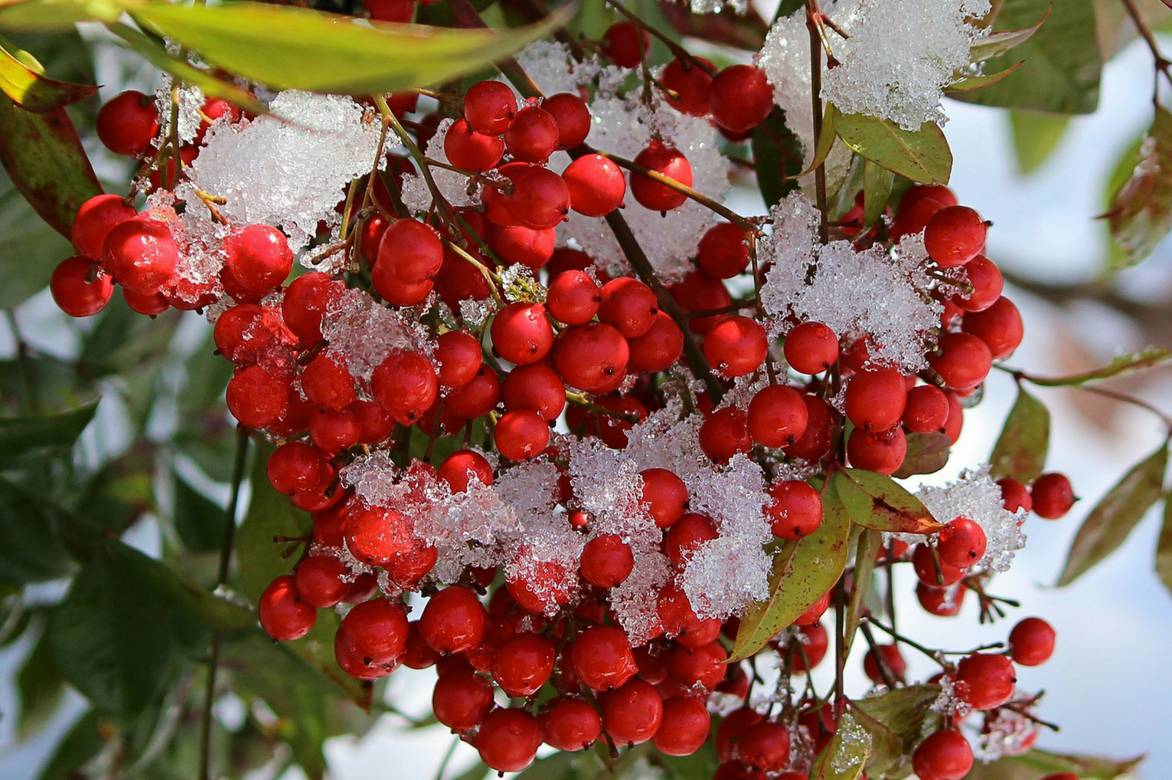
Fruit production of a nandina.
Very versatile, this beautiful shrub can be used in a border to enhance a wildflower bed, at the edge of perennial plants, or in a semi-shaded rockery. With its dense foliage of changing colours, it can also be planted as a low hedge or at the front of a flowering or mixed hedge, providing privacy, as long as it is not used to block the wind.
Its small size also makes it suitable for growing in large pots on a terrace or balcony.
When to Plant Sacred Bamboo?
The Nandina sold in containers can be planted all year round, avoiding periods of frost and drought. Ideally, to encourage its establishment, autumn planting is preferred, from September to November in warmer regions and in spring from March to May in the rest of the country.
How to Plant Nandina or Sacred Bamboo?
In the ground
It prefers deeply worked soils. It can be used in a bed, in groups of 3 or 5 plants, or in a free hedge. Space the plants 1.20 to 1.50 m apart for the larger varieties and 0.50 to 0.60 m apart for dwarf sacred bamboos.
- Dig a hole three times wider than the pot
- Loosen the soil well
- Add a good layer of pumice or gravel at the bottom of the hole
- Mix half garden soil with peat, potting soil, or compost
- Plant the shrub at collar level
- Backfill the hole while keeping the shrub upright
- Firm the soil around the base of the plant
- Water thoroughly
- Mulch the base to retain some moisture
- Monitor watering during the first two years

Planting a nandina
Growing Sacred Bamboo in a Pot
Choose compact varieties like ‘Fire Power’ and a pot with a diameter of 20 to 30 cm.
- Spread a good layer of drainage (gravel or clay balls)
- Make a mixture of good rich potting soil for shrubs with added peat
- Mulch the base
- Water the Nandina in the pot regularly, especially in summer when the soil is dry
- Place your pot indoors or on a terrace sheltered from direct sunlight and strong winds.
→ Learn more in Growing Nandina in a Pot: All Our Tips and Which Nandina or Sacred Bamboo to Choose for Your Garden or Patio?
Pruning and care
Easy to grow, Nandina requires little care and maintenance. Ensure it does not lack water during its first summers.
Plan for regular watering during the first two years after planting to encourage its establishment. Once well established, Nandina domestica tolerates drought fairly well and can do without watering, except in cases of prolonged drought. Excess water could cause the roots to rot.
In contrast, potted Nandinas have greater water needs; water regularly, especially in summer and mulch each spring.
In regions with very harsh winters, every autumn, spread a thick layer of leaf mulch, compost, partially decomposed manure, or bark mulch at the base of the bush to protect its roots from the cold.
For Sacred Bamboos in pots, refresh the topsoil every autumn.
When and how to prune the Sacred Bamboo?
Pruning is not essential; it involves cutting back stems damaged by winter cold or faded flowers. It helps maintain a nice bushy and compact shape for the bush, stimulates the production of shoots that appear at the base, and ensures the continuous renewal of stems, thus rejuvenating the plant.
It is limited to removing dead or dried wood, excessive branches, and weak shoots, and slightly cutting back stems that compromise symmetry.
- Do not prune too early in winter, as the stems may freeze; proceed after frosts in March-April, when the berries have fallen
- If the aerial parts of the bush have been damaged by frost, cut the plant back to ground level, it will regrow from the base
Diseases and potential pests
The Nandina is particularly resilient, is not often parasitic, and withstands pollution well. However, in urban areas, it may suffer from scale insect attacks: spray with rapeseed oil to suffocate the unwanted pests.
It may be more susceptible to disease, a virus transmitted by aphids and sucking and piercing pests, which causes the leaves to become narrower, stunted, and deformed, but it will survive without issue: monitor for the appearance of aphids and carry out regular sprays of soapy water.
To learn more, read our article: “Diseases and Parasitic Pests of Nandina“.
Multiplication
If sowing is possible, it is done through cold stratification but can be slow and unpredictable. You can easily propagate Nandina by separating suckers or by semi-woody cuttings or semi-ripe cuttings.
By separating suckers
- In spring, from a vigorous plant, use a spade to separate the shoots with roots
- Replant immediately in a pot placed in a cool, semi-shaded area until they take
- Be sure to water well
- Transplant into the ground the following autumn
Semi-woody cuttings
- In summer, between mid-July and September, take cuttings of 8 to 10 cm from the lower branches that are semi-ripe, meaning they are harder and woody
- Remove the leaves from the bottom of the cutting, keeping those at the top
- Dip the base in rooting hormones
- Plant the cuttings in buckets, in a mixture kept moist of river sand and potting soil
- Keep sheltered from frost all winter in a humid environment until rooting, which is slow
- Keep in pots for two years before transplanting the cuttings into the ground
Associating sacred bamboo with the garden
With its airy and changing foliage, the Sacred Bamboo beautifully dances with the wind and light, awakening the somewhat dull areas of the garden throughout the seasons. It is precious in a seaside garden or, as it is resistant to pollution, it is also perfect for urban gardens. It will fit well into a vibrant hedge or a flowering bush bed, in a garden without a gardener, from the most classic to the most Japanese-inspired.
It pairs well in hedges with all types of bushes such as Shrub Peonies, Mountain Laurels, and accompanies other acidophilous plants like Camellias, Rhododendrons, Hydrangeas, and Andromedas, which it will lighten in appearance.
Nandinas fit well in both contemporary gardens and in wild-looking gardens, creating stunning autumn scenes with grasses like Pennisetum and Stipa tenuifolia.

An example of a contemporary association: Pennisetum alopecuroides f. viridescens, Nandina domestica, Stipa tenuifolia.
In a mixed and flowering hedge, it can be paired with a Deutzia, a golden-leaved Japanese Spiraea, a Fothergilla like Leycesteria formosa ‘Purple Rain’, a Viburnum, or a Butterfly Bush, or even accompanied by shrub roses as well as Mexican Orange Blossom.
The elegance of its habit deserves to be placed among smaller plants that will not obscure its silhouette. These are all reasons to reserve a spot for it in front of larger bushes, such as ceanothus or dogwoods.
It is possible to variegate several varieties of Nandina for a beautiful effect in a hedge or a bed.
In a Japanese plant composition, to primarily play on foliage effects, Japanese maples and Euonymus with mahogany hues, along with bamboo, will echo the fruits and leaves tinged with bronze or purple of the Sacred Bamboo.

An example of an association: Acer pensylvanicum, Nandina domestica ‘Filamentosa’, Miscanthus sinensis ‘Afrika’, Picea pungens ‘Glauca Globosa’
Placed at the back of a bed, it easily associates with perennials like rudbeckia, euphorbias, crocosmia, daylilies, or opulent summer flowers like dahlias. Love-in-a-mist and Lythrum are also good herbaceous partners. Chrysanthemums in vibrant tones and helenium will take over within the bed.
In autumn, its fiery foliage will beautifully complement the Cercidiphyllum japonicum (the Caramel Tree), smoke trees, sumacs, rowans, witch hazel, lindera, deciduous azaleas, or even Stephanandra tanakae and Leucothoe, whose highly ornamental foliage evolves just like its own throughout the seasons.
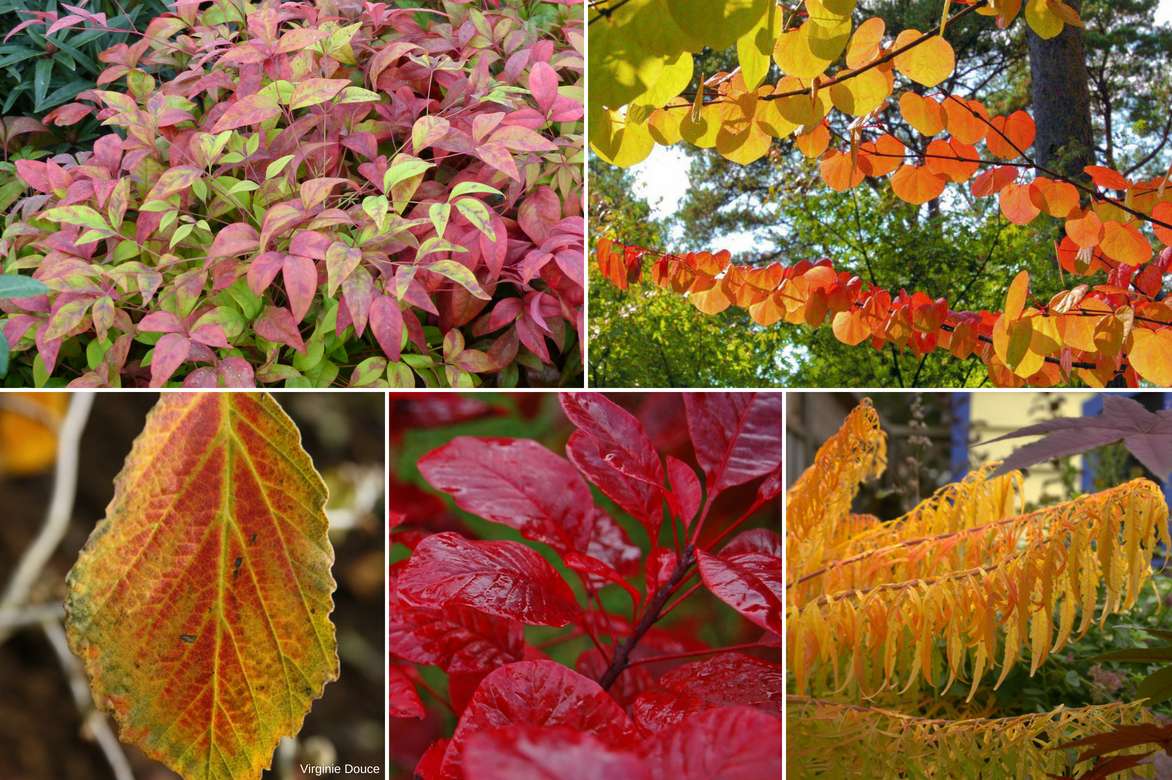
An idea for an autumn association: Nandina domestica ‘Gulf Stream’, Cercidiphyllum japonicum, Hamamelis intermedia ‘Jelena’, Cotinus ‘Grace’, Rhus typhina ‘Tiger Eyes’.
Its fruiting with decorative red berries will pair well with that of Cotoneaster or ornamental Crab Apples, Berberis, and Callicarpa.
Dwarf varieties planted at the front of a border will pair beautifully with Heucheras.
Plant early daffodils and late tulips at the base of the shrub to create beautiful colour surprises; these bulbs will accompany the Sacred Bamboo from early spring until its flowering.
Useful resources
Discover:
- our sacred bamboo collection: the most beautiful varieties of Nandinas are in our nursery!
- Also discover our articles: “Sacred bamboo: the most beautiful Nandina to grow in pots” and Nandina domestica: a reliable choice among decorative foliage plants.
- Like sacred bamboo, these bushes enjoy dappled shade: make your choice from these flowering plants for shade
- Some stunning associations with Nandinas
- Find our tips on how to water a bamboo in a pot properly.
- Subscribe!
- Contents
































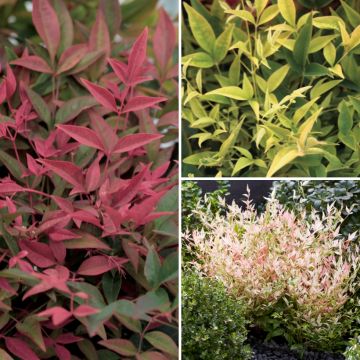


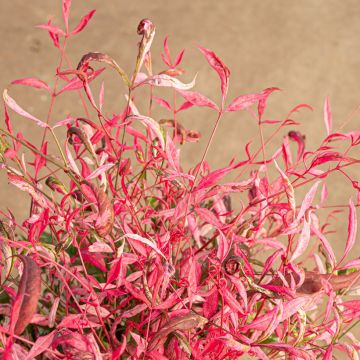

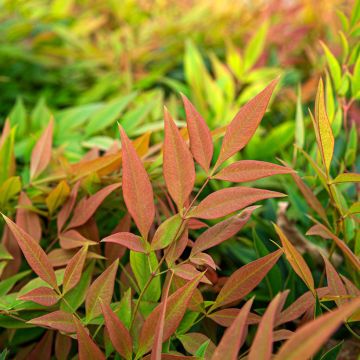


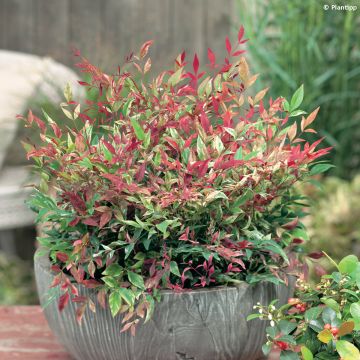
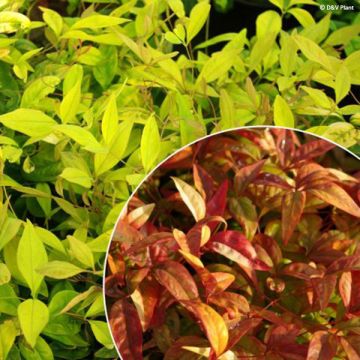
Comments